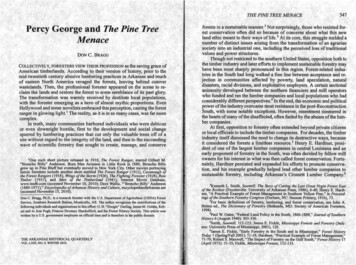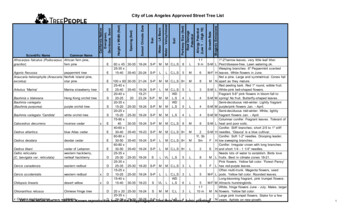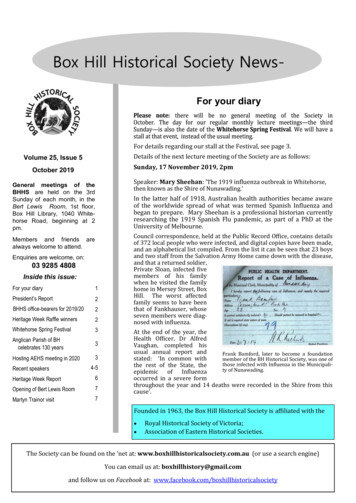
Transcription
THE PINE TREE MENACEPercy George and The Pine TreeMenaceDON C. BRAGGCOLLECTIVELY, FORESTERS VIEW THEIR PROFESSION as the saving grace ofAmerican timberlands. According to their version of history, prior to themid-twentieth century abusive lumbering practices in Arkansas and muchof eastern North America ravaged the forests, leaving behind cutoverwastelands. Then, the professional forester appeared on the scene to reclaim the lands and restore the forest to some semblance of its past glory.The transformation was warmly received by destitute local popUlations,with the forester emerging as a hero of almost mythic proportions. EvenHollywood and some novelists embraced this perception, casting the forestranger in glowing light. 1 The reality, as it is in so many cases, was far morecomplex.In truth, many communities harbored individuals who were dubiousor even downright hostile, first to the development and social changespurred by lumbering practices that cut only the valuable trees off of asite without regard to the integrity ofthe land, and then to the succeedingwave of scientific forestry that sought to create, manage, and conserve'One such short picture released in 1910, The Forest Ranger, starred Gilbert M.Anderson. Born Max Aronson in Little Rock in 1880, Broncho Billygrew up m Pme Bluff but eventually moved to New York City. Other movies portrayingheroic foresters include another short entitled The Forest Ranger (1912), Cavanaugh ofthe Forest Rangers (1918), Wings of the Storm (1926), The Fighting Forester (1928), RawTimbe (1937), and Men of the Timberland (1941); Internet Movie Database,www.lmdb.com (accessed November 10,2010); Dave Wallis, '''Broncho Billy' Anderson(1880-1971 )," Encyclopedia ofArkansas History and Culture, encyclopediaofarkansas.net(accessed November 15, 2010)."Bronch Bi ly"Don C. Bragg, Ph.D., is a research forester with the U.s. Department of Agriculture (USDA) ForestService, Southern Research Station, Monticello, AR. The author recognizes the contributions of thefollowing individuals and organizations to this effort: O. H. "Doogie" Darling, James M. Guldin, Robert and Jo Ann Pugh, Frances Devaney Shackelford, and the Forest History Society. This article waswritten by a U.S. government employee on official time and is therefore in the public domainTHE ARKANSAS HISTORICAL QUARTERLYVOL. LXIX, NO . 4, WINTER 2010347forests in a sustainable manner.2 Not surprisingly, those who resisted forest conservation often did so because of concerns about what this newland ethic meant to their ways of life. 3 At its core, this struggle melded anumber of distinct issues arising from the transformation of an agrariansociety into an industrial one, including the perceived loss of traditionalvalues and power structures.Though not restricted to the southern United States, opposition both tothe timber industry and later efforts to implement sustainable forestry mayhave been most sharply pronounced in this region. Forest-related industries in the South had long walked a fine line between acceptance and rejection in communities affected by poverty, land specUlation, naturaldisasters, racial divisions, and exploitative employers. A certain sectionalanimosity eveloped between the northern financiers and mill operatorswho funded and ran the lumber companies and local populations who hadconsiderably different perspectives. 4 In the'end, the economic and politicalpower ofthe industry overcame most resistance in the post-ReconstructionSouth, with some notable exceptions. However, resentment simmered inthe hearts of many of the disaffected, often fueled by the abuses of the lumber companies.At first, opposition to forestry often extended beyond private citizensor local officials to include the timber companies. For decades, the timberindustry itself dismissed the need to change its destructive ways, becauseit considered the forests a limitless resource. s Henry E. Hardtner, president of one of the largest lumber companies in central Louisiana and anearly proponent of forestry in the South, was often derided by fellow millowners for his interest in what was then called forest conservation. Fortunately, Hardtner persisted and expanded his efforts to promote conservation, and his example gradually helped lead other lumber companies tosustainable forestry, including Arkansas's Crossett Lumber Company.6ZKenneth L. Smith, Sawmill: The Story of Cutting the Last Great Virgin Forest Eastof th:; Rockie (Fayetteville: University of Arkansas Press, 1986), 6-48; Henry E. Hardtner, A Practtcal Example of Forest Management in Southern Yellow Pine" in Proceedings ofthe Southern Forestry Congress (Durham, NC: Seeman Printery, 191'6),73.3For basic definitions of forestry, lumbering, and forest conservation, see John A.Helms ed., The Dictionary of ForestlY (Bethesda, MD: Society of American Foresters1998).'4Paul W. Gates, "Federal Land Policy in the South, 1866-1888," Journal of SouthernHistOlY 6 (August 1940): 303-330.5Smith, Sawmill, 112-123; James E. Fickle, Mississippi Forests and ForestlY (Jackson: University Press of Mississippi, 2001),120.6James . Fickle, "Early Forestry in the South and in Mississippi," Forest HistoryToday 7 (Spnng/Fall 200 I );, 11-18; Hardtner, "Practical Example of Forest Management,"71-79; Robert S. Maxwell, The Impact of Forestry on the Gulf South" Forest Histol"V 17(April 1973): 31-35; Fickle, Mississippi Forests, 132-133.'-
348ARKANSAS HISTORICAL QUARTERLYBy the mid-I920s, a number of the major Arkansas timber operationswere seriously considering the management of cutover lands as an alternative to abandoning the area for the western U.S. or bankruptcy. Even theConcatenated Order ofHoo-Hoo, a national lumber industry-based fraternal organization founded in Gurdon, Arkansas, had made the conservation of forest resources and reforestation of denuded lands their principalinterest by 1925. 7 The conversion of the industry to forest conservationdid not translate to universal local acceptance of either the industry or forestry, though.Nowadays, the piney woods of southern Arkansas seem to be anunlikely location for forestry-related strife. Journeying through th.elow, rolling hills of the Upper West Gulf Coastal Plain takes a travelerthrough mile after mile of industrially owned tree plantations. Mostlands are covered with thick stands of pine, oak, hickory, gum, andother hardwoods. This abundant timber resource fuels a significant industry-with only about 3.4 percent of the nation's forested lands, andjust less than I percent of its population, Arkansas contributes almost4 percent of the forest products generated nationwide. 8 Directly or indirectly, the Arkansas forest products industry currently employs tensof thousands of people with a multi-billion dollar payrol\.9 During lumbering's heyday between 1895 and 1925, Arkansas forests annuallyyielded over 1.5 billion board feet of lumber and up to 5 billion boardfeet for all wood used (including firewood, pulpwood, lath, cooperage,shingles, crossties, and lumber). Manufacturing associated with wood7William L. Hall "Arkansas' Romance Reforestation," Nature Magazine 6 (October1925): 233-236; Farr;r Newberry, "The Concatenated Order of Hoo-Hoo," Arkansas Historical Quarterly 22 (Winter 1963): 301-310.8Arkansas population estimate for 2003, U.S. Census Bureau, Arkansas Quick 0 . html(accessedAugust23,2005 .In 2002,Arkansas harvested an estimated 680 million cubic feet of hardwood and comfer roundwood from almost 18.8 million acres of forestland; James W. Bentley, Michael Howell,and Tony G. Johnson, Arkansas' Timber Industry-An Assessmellt of Timber Product Output and Use, 2002, SRS-RB-99 (Asheville, NC: USDA Forest .S rvice, .2005), I. Th.enational figures were 18.2 billion cubic feet of roundw?od (10.7 bllh , n cubIc feet of comfers, 7.5 billion cubic feet of hardwoods) from approxImately 558 mIllion acres of forestland; Richard W. Haynes, David J. Brooks, David B. McKeever, and Kenneth E. Skog,"Overview" in An Analysis of the Timber Situation in the Ullited States: 1952 to 2()50, ed.Richard W. Haynes (Portland, OR: USDA Forest Service, 200 ), 8; Darius .M. Adams,Richard W. Haynes, Peter J. Ince, Kenneth E. Skog, John R. MIlls, and DaVId B. McKeever, "Timber Demand-Supply Relations: Base Projection," in ibid., 96.9Division of Agriculture, Economic Impact of Arkansas Agriculture-201() (Fayetteville: University of Arkansas, 2010), 23; Richard A. Williams, "Arkansas ForestsThe Timber Resource," in Proceedings of the Symposium on Arkansas Forests: A Confe ence on the Results of the Recent Forest Survey of Arkansas, ed. James M. Guldm(Asheville, NC: USDA Forest Service, July 2001), 17-23.THE PINE TREE MENACE349contributed significantly to the state's economic well-being. In fact,one government report estimated that in lumbering's peak year of 1909the fore t products industry employed 73 percent of all factory wageearners m Arkansas. As late as 1927, 63 percent of these earners weretied to timber, with most of this production occurring in the southernhalf of the state. 10 Yet surprisingly enough, one of the most vocal agitators against the timber industry also came from that part of the state.In 1928, .Gaston Per y eorge (better known simply as PercyGeorge) publIshed and dlstnbuted a booklet entitled The Pine TreeMena,ce, a vivid. example of opposition of forest management. II Apromment figure m southeastern Arkansas prior to World War II PercyGeorge was born in Hamburg, Arkansas, on March 25, 1873, th'e thirdof ten children of Gaston Percy George (1844-1909) and Josie A.Georg.e (1852-1900). He attended Hamburg public schools beforespendmg three years studying literature at Southern Normal Universityin Huntingto.n, ennessee. After college, he returned to Hamburg andstarted workmg In t e law office of R. E. Craig before being admittedto t e !-IaTbur? ar I 1898 . On January 7,1907, Percy George marriedAbigaIl Ab le ElIza WIlson (1876-1936), daughter of longtimeHamburg reSIdents A. H. and Eliza Wilson. During his years inHa b.urg,. Per.cy became active with the Masons and in politics, brieflypartIcIpatIng m the Arkansas Constitutional Convention of 1917 andservin .as Ashley County judge from 1929 to 1932 and 1935 to 1936.In addItIon to his legal practice, he acquired interests in local banks ahotel, and other businesses, including newspapers. 12 George edited a d"fO!. T. Harris .and Hu Maxwell, "Part I.-Uses and Supply of Wood in Arkansas, m Wood-Usl'!g Industries and National Forests of Arkansas (Washington:USDA FO, est S.ervlce, 1912), 5-7; E. Murray Bruner, "Forestry and Forest Fires inArkansas, Agricultural Extension Service Circular 281 (Fayetteville: University ofArkansas, 193 ),.I 1-16; John Gray, Arkansas Forest History (Little Rock: ArkansasForestry ASSOCIatIOn), www.arkforests.org/favorite-history html (accessed March 272009). ,::Gaston Percy George, The Pin Tree !'1enace (Hamburg, AR: self-published, 1928).Dalla . Herndon, Centenmal HIstory of Arkansas, 3 vols. (Chicago: S. J.Clarke Pubhshmg Company, .922),2:386-389; Alice Kennedy Lee, Excerptsfrom theAsh.ley County Eagle, Arkansas, 1889-/9/4 (Crossett, AR: self-published, 2000), 84,174, Dallas T. . H rndon, Annals of Arkansas, 4 vols. (Hopkinsville, KY: HistoricalRecords ASSOCIatIOn, 194:), I :257-258; Robert A. Carpenter, Sr., and Mary ImogeneNoble Carpenter, ReflectIOns of Ashley County (DaUas: Curtis Media Corporation1987), 90, 15.0; Fred W. Allsopp, History of the Arkansas Press for a Hundred Year;alld More (LIttle Rock: Pa ke-Harper Publishing, 1922), 56-57; Proceedings of theForty-!'o.urth Annual Meeting of the Bar Association of Arkansas (Little Rock: BarASSOCIatIon of Arkansas, 1941), 150.
ARKANSAS HISTORICAL QUARTERLY350Percy and Abbie (Wilson) George, circa 1920. Photo from Dallas T. Herndon 's Centennial History of Arkansas.owned the Ashlev County Leader, and it was in this capacity that hewrote the edito;ials that would be combined into The Pine TreeMenace.,.The first paragraph of thIS booklet spelled out George s concel ns regarding the growing push for conservation in Arkansas:A Forest Conservation law to be applied to lands suit.a ble for agricultural purposes is wrong. The attempt to grO\ pme trees onlands needed and suited for farms and ranches IS rong. Ourmind is made up as long as we live with the present lights beforeUS.13For fifty-eight pages, The Pine Tree Menace .rehashed. George's opposition to what he deemed a dangerou usurp tlOn of nvate pro ertyrights by legislation promoted by the timber mdustry m a conspIracywith the government.llGeorge, Pille nee Menuce, I.THE PINE TREE MENACE351Collaboration between the industry and public officials was, in fact,occurring but not to the nefarious end supposed by George. Since at leastthe early 1920s, a number of private citizens, timber companies, and thefederal government had been pressuring the Arkansas legislature to establish a state agency dedicated to forestry, reforestation, and wildfire protection. The U.S. Department of Agriculture even offered an allotment of 43,560 in a fifty-fifty cost share to help support the agency in 1929. However, the requisite enabling legislation generated a tepid response, garnering only 15 affirmative votes out of a possible 100. 14 Opposition frompeople such as George helped delay the establishment of a state forestrycommission for years and then contributed to the desperate underfundingof the agency for at least the next decade.George centered his opposition to this legislation around a number ofthemes. These arguments can be broadly summarized as:I) agricultural lands should continue to be fanned or be kept open forhomes and crops, not converted back into timber, since forests are uncivilized and reforestation represents the degradation of civilization;2) the forest conservation law, George imagined, would eventuallylead to an immoral seizure of productive farmlands from average citizensto increase the wealth of a few timber barons; and3) these timber interests were largely northern capitalists bent on exploiting southern forests, with no interest beyond making money and nodesire to pay taxes on their timbered properties, even to benefit the consvation they were promoting.Throughout The Pine Tree Menace, George counterposed agricultureand civilization with forests and savagery.Any set of men who will sit idle and permit our country to beoverrun by the timber interests are not worthy to be called husbands and fathers, and ought to don their Coon Skin caps andBearhide jackets and get him a rifle and move out of civilizationinto the pine forest, where your children will grow up in ignorance and in time become savages. The pine tree forest proposition is repulsive to the finer sensibilities of an intelligent andenlightened people. The days of the Cave man are over and we14W. K. Williams, "Address," in Proceedings of/he Fifth SOli/hem Fores/I)' Congress(New Orleans: A. W. Hyatt, Ltd., 1923), 86-88; A. C. Millar, "Proposed Forestry Law forArkansas," in Proceedings of the Seventh SOli/hem Fores/I)' Congress, ed. J. S. Holmes(Durham , NC: Seeman Printery, 1925), 46-50; American Forestry Association, "HydeUrges Organized Forestry for Arkansas," American Fores/s and Fares/ Life 36 (October1930): 658-659; Fred H. Lang, "Two Decades of State Forestry in Arkansas," Arkansas//is/orical Quar/erly 24 (Autumn 1965): 208-219.
352ARKANSAS HISTORICAL QUARTERLYTHE PINE TREE MENACE353are unwilling to be reduced to this intolerable and miserable condition in life, merely for the sake of allowing a few men to makemoney. ISPercy George even sought to exploit primal fears of the forested wilderness and the agents of destruction that purportedly accompanied thiscondition:Out in the Bearhouse neighborhood, wild animals are becoming sonumerous that it is almost impossible to raise hogs, goats, orcalves. The other day Mr. A. L. Mitchell shot down and killed alarge wolf near his home. This wolf was trying to catch his flockof geese . Last week Mr. Allison on Beech Creek, killed a RattleSnake very near his home that was over five feet long and carriedenough poison in its fangs to kill the entire Allison family . . Outeast of town the farmers are having considerable trouble keepingthe deer from destroying their corn and pea crops, and in the Berlinneighborhood, coons and wild turkeys are doing much to damagethe crops . When Divine Providence created Ashley, Drew andBradley counties, it was done for the accommodation of his people. God made Pine trees to serve humanity, but he did not makehumanity to be pushed back and give Pine trees room to grow andflourish. 16The cover of The Pine Tree Menace, from a copy owned by theUniversity of Arkansas at Monticello. The handwritten noteson the cover were made by Albert Edward Wackerman, afonner Crossett Lumber Company forester who also worked atthe Crossett Experimental Forest of the U.S. Forest Service'sSouthern Forest Experiment Station. Courtesy Don C. Bragg.George exaggerated the extent of the wildlife problem experiencedby farmers. By the time The Pine Tree Menace appeared, overhuntingand habitat loss had driven many animal species to the very brink of extinction. A 1930 surveyor Arkansas animals estimated there were 500white-tailed deer, a couple thousand wild turkeys, and a few dozenwolves statewide (compared to about I million deer and more than150,000 turkeys today--wolves remain extirpated in Arkansas). Eventhe relatively common raccoon declined sharply, prompting the ArkansasGame and Fish Commission to actually stock dozens of this species insoutheastern Arkansas during the 1930s and 1940s.1 7George was not alone in his preference for farmlands over forest.Henry Hardtner recounted the story of a prominent landowner who soughtto take advantage of Louisiana 's program of property tax breaks for tor15George, Pille Tree Mel/ace, 42.Ir.lbid., 51.17T. H. Holder, A Survey olArkal1sl/S Game (Little Rock: Arkansas Game and FishCommission, 1951),67,83,97-9,), 147-153.
354ARKANSAS HISTORICAL QUARTERLYTHE PINE TREE MENACEested lands, only to be "told very plainly that they [the assessor, police jury,and other officials] did not want forests- that they wanted farms andwould raise his assessment on other properties if he persisted in growingtimber."IRIn addition to identifying agriculture with civilization, George identified conservation efforts not only with the government but with the timberindustry. He believed that forest conservation involved attempts by industry to unjustly manipulate the tax code. According to George, the timbercompanies were actively working the Arkansas legislature to exempt landsemployed solely for timber culture from taxation, to secure 12,000 perannum to hire government agents to prevent animals (and men) from trespassing on company properties, and to fund the construction of fire towersand take other protective actions on these lands. George proposed th.atthese "wicked laws" be replaced by a "graduated land tax law that willplace these lands within reach of our people for homes.,,19.George insisted that forest conservation was a ploy by the timber I dustry and the federal government to deprive private landowners of theirinherent right to property. Some of the federal government's first conservation efforts in Arkansas had indeed been controversial. The formation ofthe Arkansas (now Ouachita) and Ozark National Forests fro the publicdomain in 1907 and 1908, respectively, and the implementatIOn of rulesand regulations for them had not expropriated private land, but they hadreined in free-for-all use of public lands, rubbing many Arkansans thewrong way.20 Others resented the efforts by the U.S. Forest Service, industry, and other agencies to discourage. their che.rished practi e o woodsburning to kill ticks and snakes and to Improve hvestock g azlng . Georgeworried that such regulations might force farmers off their own lands, allowing lumber companies to acquire them on the che p .George's chief concern about forest conservatIOn laws. seemed tohinge on who would control cutover lands- the government, Industry, orfarmers. Sustainable forestry meant companies would keep their cutoverland rather than selling it off to individuals who would farm it. PercyGeorge even denounced an outreach program initiated by Ashley County'sCrosset.t Lumber Company to encourage farmers and other citizens to protect their forested lands from fire. According to George:1RHardtner. "Practical Example of Forest Management," 73.'"George. Pine Tree Menace, 13. Undoubtedly, large indu trial forest landownersardently desired to lower their property taxes. Hardtner avor ? a small tax on the"landeach year and a large [severance] tax when the tree crop IS eut. Henry E. Hardtner, For.estry at Urania, Louisiana," ./ol/mal of Foresfl), 30 (March 1932): 3 J 1.2 Stephen Strausberg and Walter A. Hough, "The Ouachita and Oz rk-St. FrancIsNational Forests: A History of the Lands and USDA Forest Service Tenure, USDA ForestService SOl/them Research Station General Technical Report SO-I21 (Asheville, NC:USDA Forest Service Southern Research Station, J 997): 8- J 7.21Many southern rs' long-held tradition of setting fire to the woods during dry periods of the year so vexed the U.S. Forest Service that it employe a psy hologlst to studythese poor rural residents and suggest new strategies to combat thiS practice; John P. Shea,"Our Pappics Burned the Woods," American Forests 46 (April 1940): 159- J 62, 174.355 here are prizes now being offered by the timber holding corporatIOns to our school children to write pieces on "why the timbershould be protected and a law of forest conservation passed." Wethink this is an insult to our intelligence and the parents who knowbetter should not allow their children to be made parties to thisfraud. This matter is being handled through ollr schools and thesevery schools that the timber holding corporations are using to encourage timber protection, would all be destroyed if the forest conservation law was passed, allowing the timber interest to deedtheir lands to the United States and retain perpetually all timber,stone and mineral rights. This would relieve all these lands fromall kinds of taxes and then where would our schools be[?f2A booklet published in March 1924 by the Crossett Lumber Company's nascent forestry program included two such student essays, one byan eleventh-grade student named Mary Riley and the other by tenth-graderGrace Blakemore. Both students roundly condemned the destruction andwastefulness of forest fires while touting the benefits of a vibrant timberindustry. Riley stated:Timber has played a master part in the building ofthe South. It hasdone, is doing, and will do many constructive things. It will paytaxes, afford employment and furnish business to our railroads.T axes will build and maintain our roads, schools and publicutlhtles. The employment will make good citizens. create industries and uphold our social life. Take away the timber from theSouth and thousands oflittle towns will practically disappear witha consequent train of business depression .2JBlakemore offered:22George, Pine n'ee Menace, 2.BMary Riley. "Preventing Forest Fires in Ashley County," in Timber Growing onFarm Woodlal1d and Forest Fire Prevention (Crossett, AR: Crossett Lumber Company,Departme t of Forestry, 1924), 8- J2. The booklet also promoted returning certain farmedareas. to timber,. espeCially those too poor, rugged, or erodible for the era's agriculturalpractices, and discouraged farmers from burning their properties.
356ARKANSAS HISTORICAL QUARTERLYThe zeal for ridding the land of forests to make room for agriculture has over-shot its mark. A very large aggregate of cut-overland, some of which has never been brought under the plow, isnow non-productive. The community does not benefit, but suffers,when forests are destroyed and agriculture is introduced on landwhich it cannot permanently hold and this is unfortunately too little realized. Such a course is either an economic and social blunderor a social crime . The wasteful [agricultural] methods employed by our forefathers are responsible for only two men out ofevery ten of this generation being able to own their homes. 24Both ofthese essays stand in stark contrast to George's views on agriculture and forest conservation and may have prompted him to start the series of editorials in the Ashley County Leader. George may also havesought to counter the efforts of Dr. Alexander Copeland Millar, a prominent Methodist minister, educator, publisher, and prohibitionist. Millar wasone of the initial appointees to the Honorary Arkansas Forestry Commission by Gov. Thomas McRae, who charged the group with "studying, formulating and submitting a plan for the protection, preservation andperpetuation ofthe forests of Arkansas." As secretary for the group, Millarplayed a pivotal role in drafting the initial proposed legislation for the Arkansas State Forestry Commission, which explicitly included the hiring ofa state forester and other agents to enforce forest conservation laws, rules,and regulations, and promote fire control, tree planting, and the public acquisition of private lands. Starting in 1924, Millar had toured Arkansaspromoting forest conservation at schools and other public organizations. 25While holding Dr. Millar in the highest regard, George flatly stated:Mr. Miller [sic] was selected for the position he holds because heis well known as a Christian, God-fearing man and is a man inwhom the people have confidence, but Dr. Miller is wrong. We believe he is honestly wrong and would not attribute any but the purest motives to Dr. Miller, and we hope and believe that when hegets into the real selfish motives behind the Forest Conservation24Grace Blakemore, "Why It Is Necessary to Prevent Forest Fires in Ashley County,"in ibid., 14-15.25Thomas Rothrock, "Dr. Alexander Copeland Millar," Arkansas Historical Quarter(v 22 (FaIl 1963): 215-223; Lang, "Two Decades," 208-2 I 9; Michael Strickland, "Alexander Copeland Millar (1861-1940)," Encyclopedia of Arkansas History and Culture,encyclopediaofarkansas.net (accessed August 17,2009); Millar, "Proposed Forestry," 4650.THE PINE TREE MENACE357movement that he will spurn any further connection with it. Weknow Dr. Miller well and know he is a good man and when hetakes time and considers this question in the quiet hours of hismeditation that he will face about and get right and get on the sideof the people. 26Dr. Millar apparently never came to this revelation, as he continued his efforts to promote forest conservation, serving on the state forestry commission after its creation in 1931. Indeed, Millar may have been as responsibleas any other single individual for the formation of the commission. 27Considerable sectional animus also runs through George's critique ofthe timber industry and forest conservation:Do you know and realize that about ninety per cent of the pinelumber manufactured in Arkansas is shipped north of the Masonand Dixon line? Do you realize and know that the timber holdingcorporations are owned by those of our northern kin, who have nointerest whatever in the good and welfare of our people. 28He later asserted:In a vast majority of the counties of Southern Arkansas, a bunchof millionaires from the North are gradually acquiring our landsthat are especially adapted to the growth of cotton, com, potatoes,hay and all other crops . converting these fertile and productivelands into timber growing lands and pushing back further and further the people. These rich men are behind a propaganda of ForestConservation. 29He added:The great majority of our legislature are good and honest men andwhen they learn and know the miserable condition being broughtabout by a few rich Yankees from the other side of the Mason and26George, Pine Tree Menace, 40-41. George, a fellow Methodist and Democrat, mentioned few other contemporaries in The Pine Tree Menace by name, perhaps concernedabout slander, given his incendiary commentaries. Though he failed to spell Millar's nameproperly, he must have been familiar enough with Millar not to want to sully him with personal attacks.27Lang, "Two Decades," 208-219.28George, Pille Tree Menace, 14.29Ibid., 34.
ARKANSAS HISTORICAL QUARTERLYTHE PINE TREE MENACEDixie line, will be ready and eager to render our people a real service, by relieving us from our present intolerable condition thathas been brought about by these self invited neighbors, who aretrying to eXfuloit and ruin our beautiful county for the sake of making money. 0suasion that they mar gather what relief they can from this untrueand rotten doctrine. 3358359Taken in concert, George believed his positions presented such a compelling case against forest conservation that he found it incredible thatmore people were not as stridently opposed as he was:In invoking evolution, so prominent in the national consciousness due tothe 1925 Scopes "Monkey Trial" and the 1927-1928 effort to pass ananti-evolution law in Arkansas, George attempted to exploit the animosity many Americans felt toward science as a threat to religion and localcommunity values. 34Elsewhere George invoked Moses, who:Is there anything we can say to awaken you; is there anything wecan do to awaken you; is it possible that you are to remain indif- 'ferent and stagnant and allow the timber holding corporations tooverrun and own this county; what is the matter with the people;do you think I am trying to fool you and deceive you in trying tomake you believe a condition exists that in reality does not exist;are you skeptical about the pine tree menace being only a delusionand not a reality?31placed his veto on this convenient theory of manifest destinywhen he inspired men on tablets of stone, when he wrote thisstem command, "Thou shalt not c
Per.cy became active with the Masons and in politics, briefly partIcIpatIng m the Arkansas Constitutional Convention of 1917 and servin .as Ashley County judge from 1929 to 1932 and 1935 to 1936. In addItIon to his legal practice, he acquired interests in local banks a hotel, and other businesses, including newspapers. 12 George edited a d










